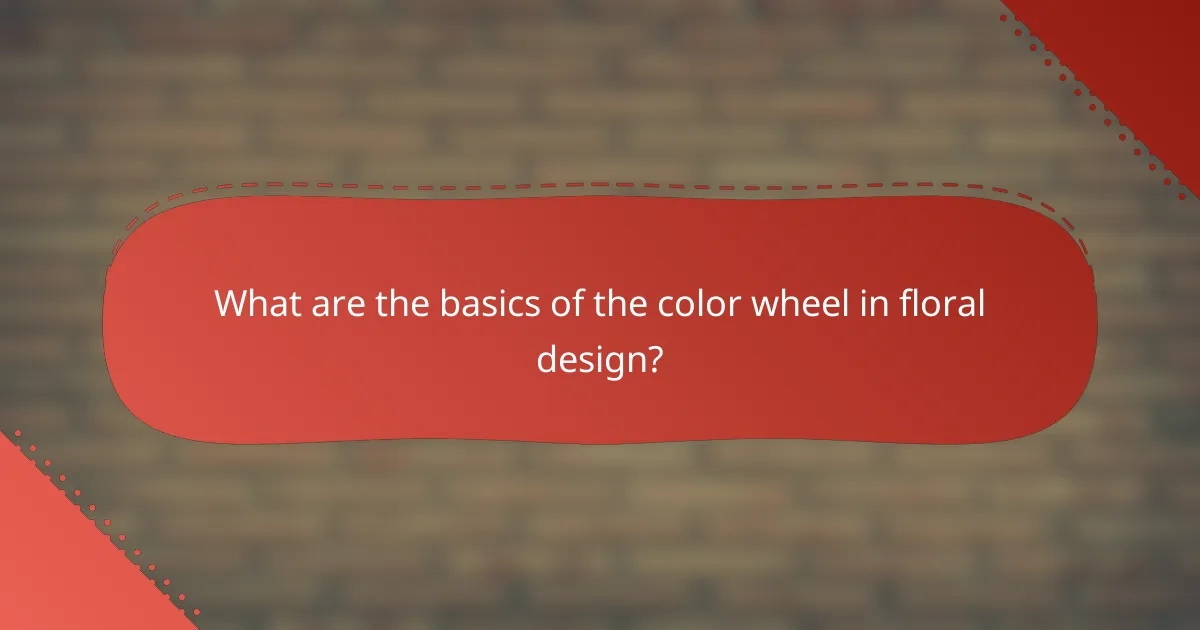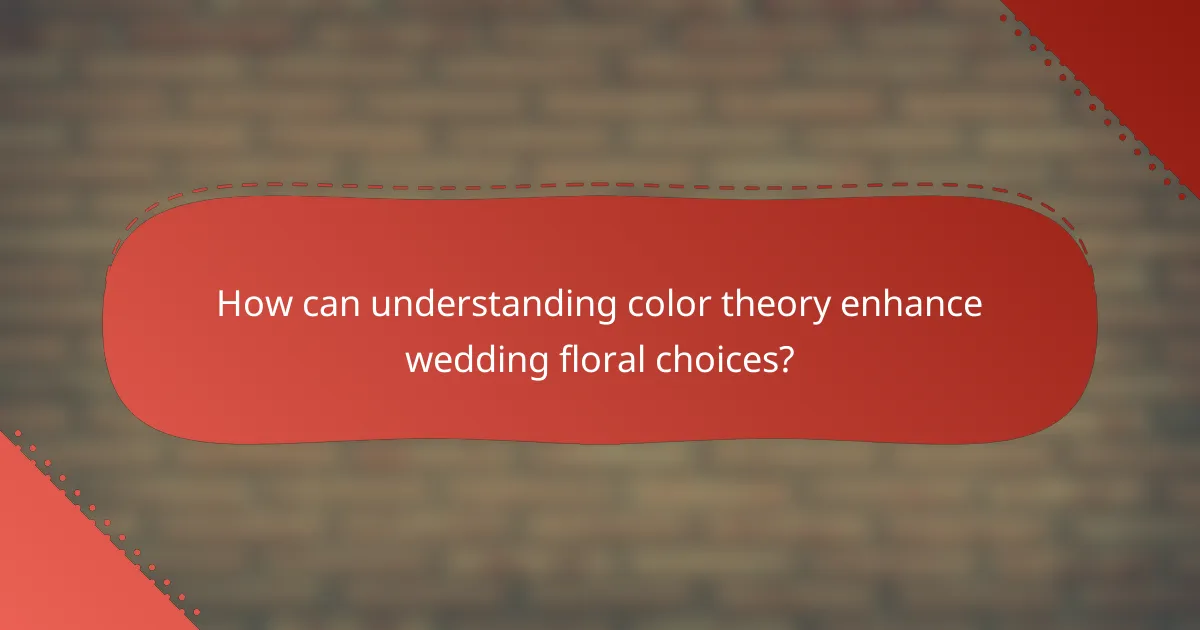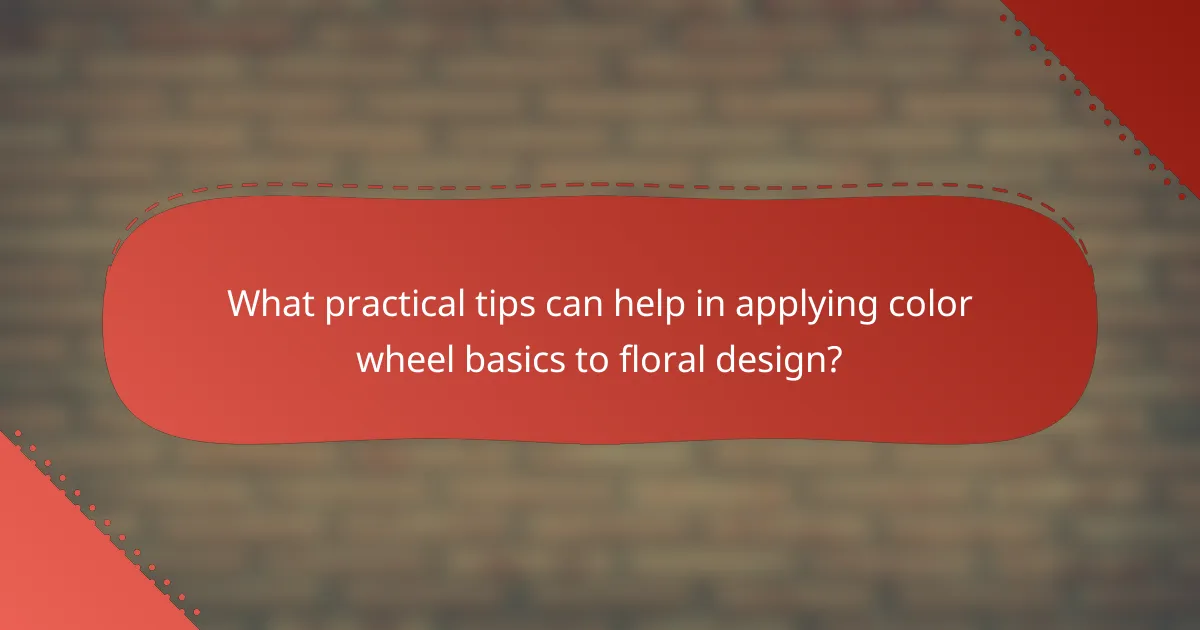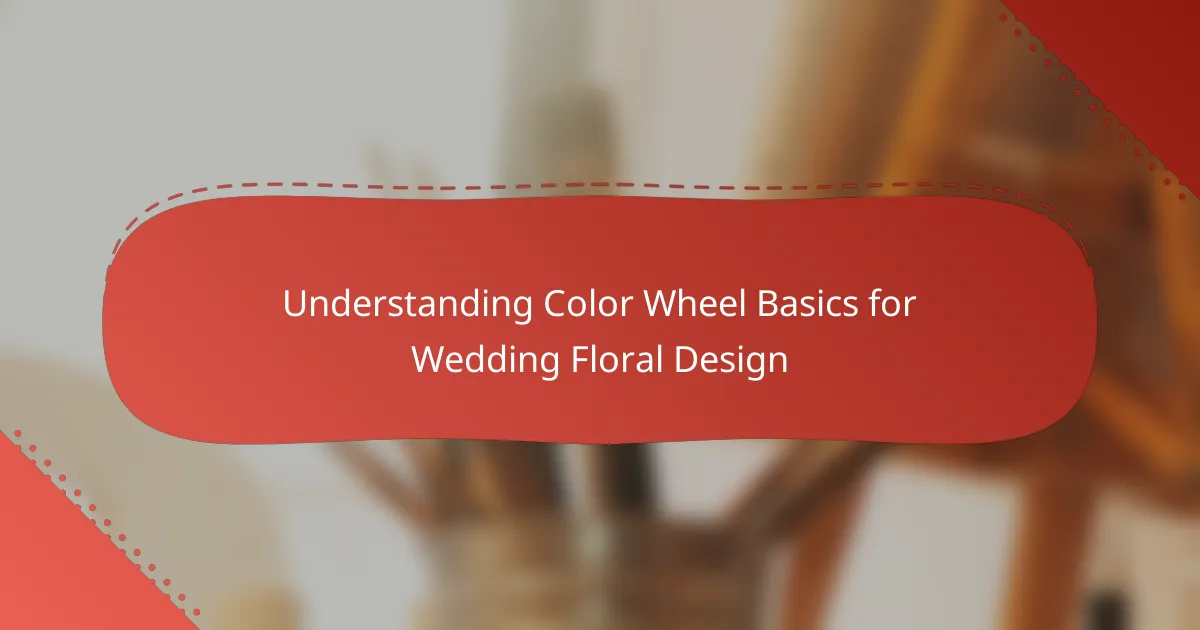
What are the basics of the color wheel in floral design?
The color wheel in floral design is a visual tool that illustrates the relationships between colors. It consists of primary, secondary, and tertiary colors. Primary colors are red, blue, and yellow. Secondary colors are formed by mixing primary colors, such as green, orange, and purple. Tertiary colors result from mixing primary and secondary colors. The color wheel helps designers create harmonious floral arrangements. Complementary colors, located opposite each other on the wheel, create contrast. Analogous colors, found next to each other, provide a cohesive look. Understanding these relationships enhances the aesthetic appeal of floral designs.
How does the color wheel influence wedding floral arrangements?
The color wheel significantly influences wedding floral arrangements by guiding color selection and harmony. Floral designers use the color wheel to create aesthetically pleasing combinations. Complementary colors, found opposite each other on the wheel, enhance visual contrast. Analogous colors, located next to each other, provide a more cohesive look.
Using the color wheel helps convey emotions associated with specific colors. For example, blue can evoke calmness, while red signifies passion. Research indicates that color choices can impact mood and perception, making the color wheel a valuable tool. Proper use of the color wheel leads to balanced and visually appealing arrangements. This approach ensures that floral designs align with the overall wedding theme and color scheme.
What are the primary colors used in floral design?
The primary colors used in floral design are red, blue, and yellow. These colors form the foundation of the color wheel. Each primary color can be mixed to create secondary colors. For instance, red and blue make purple, blue and yellow create green, and red and yellow produce orange. This color theory is essential in floral arrangements. Understanding these colors helps in creating visually appealing designs. Floral designers often use these principles to evoke specific emotions. The use of primary colors can enhance the overall aesthetic of floral displays.
How do secondary and tertiary colors enhance floral arrangements?
Secondary and tertiary colors enhance floral arrangements by adding depth and contrast. These colors create visual interest and balance within the composition. Secondary colors, formed by mixing primary colors, provide vibrant options like orange, green, and purple. Tertiary colors, made by mixing primary and secondary colors, introduce unique shades such as red-orange and blue-green.
Using these colors strategically can evoke specific emotions. For example, warm secondary colors can create a cheerful atmosphere. In contrast, cool tertiary colors can impart a sense of calm. Studies in color theory show that contrasting colors attract attention and highlight focal points in arrangements. This principle is crucial in wedding floral design, where aesthetics play a significant role.
Why is color harmony important in wedding floral design?
Color harmony is crucial in wedding floral design because it creates a visually appealing arrangement. Harmonious colors enhance the overall aesthetic of the wedding. They evoke emotions and set the mood for the event. Research shows that color combinations can influence perceptions of beauty. For instance, complementary colors create contrast and draw attention. Analogous colors offer a more serene and cohesive look. Proper color harmony can also reflect the couple’s personality and theme. This thoughtful approach to color can elevate the entire wedding experience.
What are the different color schemes that can be applied?
The different color schemes that can be applied in wedding floral design include monochromatic, analogous, complementary, triadic, and tetradic schemes. Monochromatic schemes use variations of a single hue, creating a harmonious look. Analogous schemes involve colors next to each other on the color wheel, fostering a serene palette. Complementary schemes feature opposing colors, providing high contrast and vibrancy. Triadic schemes consist of three evenly spaced colors, ensuring balance and diversity. Tetradic schemes use two complementary pairs, allowing for rich and dynamic designs. Each color scheme can significantly impact the overall aesthetic of a wedding floral arrangement.
How do complementary colors create visual interest?
Complementary colors create visual interest by providing a striking contrast. This contrast enhances the vibrancy of each color when placed next to one another. For example, blue and orange are complementary colors. When used together in floral arrangements, they draw the eye and create a dynamic visual effect. This principle is rooted in color theory, which states that complementary colors can intensify each other. Research shows that contrasting colors can increase attention and engagement in visual compositions. Therefore, using complementary colors in wedding floral design can elevate the overall aesthetic and impact.

How can understanding color theory enhance wedding floral choices?
Understanding color theory can significantly enhance wedding floral choices by guiding the selection of harmonious color combinations. Color theory explains how colors interact and the emotional responses they evoke. For instance, complementary colors create vibrant contrasts, while analogous colors offer a more serene look.
Utilizing the color wheel allows florists to choose colors that align with the wedding theme. Research indicates that color can influence mood; for example, warm colors like reds and oranges can evoke excitement, while cool colors like blues and greens can promote calmness.
A study published in the Journal of Experimental Psychology found that color affects perceptions of beauty and preference. By applying these principles, couples can create floral arrangements that not only match their style but also enhance the overall ambiance of their wedding day.
What role do warm and cool colors play in floral design?
Warm colors in floral design evoke feelings of energy and warmth. They include reds, oranges, and yellows. These colors can create a lively and inviting atmosphere. They are often used in designs for celebrations and joyful occasions. Cool colors, such as blues, greens, and purples, convey calmness and tranquility. They can create a serene and sophisticated look in floral arrangements. Combining warm and cool colors can provide balance and contrast. This approach enhances visual interest in floral designs. The use of color theory in floral design is essential for achieving desired emotional impacts.
How can warm colors evoke emotions in wedding settings?
Warm colors can evoke emotions in wedding settings by creating a sense of warmth and intimacy. These colors, such as reds, oranges, and yellows, are often associated with feelings of love and happiness. For example, red symbolizes passion, while orange conveys enthusiasm. Studies show that warm colors can stimulate feelings of excitement and energy. This emotional response is particularly effective in wedding environments, where the atmosphere is meant to be joyful and celebratory. Additionally, warm colors can enhance the overall ambiance, making guests feel more connected and engaged. The use of warm colors in floral arrangements can significantly influence the emotional tone of the event.
What effects do cool colors have on the overall ambiance?
Cool colors, such as blue, green, and purple, create a calming and soothing ambiance. They are often associated with tranquility and relaxation. These colors can make spaces feel more spacious and airy. In wedding floral design, cool colors can evoke feelings of serenity and peace. Research indicates that cool colors can lower heart rates and reduce stress. This effect is particularly beneficial in event settings where a relaxed atmosphere is desired. Studies in color psychology support the notion that cool colors can influence mood positively. Thus, incorporating cool colors in wedding floral arrangements can enhance the overall ambiance.
How can the color wheel guide flower selection for weddings?
The color wheel can guide flower selection for weddings by helping to create harmonious color combinations. It categorizes colors into primary, secondary, and tertiary hues. Using complementary colors, which are opposite each other on the wheel, can create striking contrasts. Analogous colors, located next to each other, offer a more subtle and cohesive look.
For example, pairing blue and orange can evoke a vibrant atmosphere. Meanwhile, choosing shades of pink, purple, and red can produce a romantic feel. The color wheel also aids in understanding color psychology. For instance, yellow signifies happiness, while green represents growth and harmony.
By utilizing the color wheel, couples can ensure their floral arrangements align with their wedding theme and emotional tone. This approach leads to visually appealing and meaningful floral designs.
What flowers are best suited for each color scheme?
Roses are ideal for a red color scheme. They symbolize love and passion. For a blue color scheme, hydrangeas work well. Their lush blooms create a calming effect. Sunflowers are perfect for a yellow color scheme. They bring warmth and cheerfulness. For a pink color scheme, peonies are an excellent choice. They add romance and softness. Lavender is suitable for a purple color scheme. Its fragrance enhances elegance. White lilies are best for a neutral color scheme. They represent purity and simplicity. Each flower aligns with its color scheme, enhancing the overall aesthetic.
How can seasonal availability influence color choices?
Seasonal availability significantly influences color choices in floral design. Different seasons offer distinct flowers with unique colors. For instance, spring typically features pastel shades like pink and lavender. In contrast, summer blooms often showcase vibrant colors such as bright yellows and oranges. Autumn brings rich, warm tones like deep reds and burnt oranges. Winter floral arrangements may include whites and greens, reflecting the season’s cooler palette. This variation in color availability aligns with nature’s cycles, impacting designers’ choices for weddings. Seasonal floral trends often dictate popular color schemes, guiding couples in their selection.

What practical tips can help in applying color wheel basics to floral design?
Use complementary colors for vibrant contrasts in floral arrangements. Pair colors opposite each other on the color wheel. This technique creates visual interest and harmony.
Incorporate analogous colors for a more cohesive look. These colors sit next to each other on the wheel. They blend well and create a serene effect.
Utilize the triadic color scheme for balance. Select three colors evenly spaced on the wheel. This approach offers a dynamic yet balanced arrangement.
Consider the color temperature of flowers. Warm colors evoke energy, while cool colors provide calmness. Mixing both can enhance the overall design.
Experiment with varying shades and tints. Lighter or darker variations of a color can add depth. This technique enriches the visual texture of the arrangement.
Incorporate neutral colors to ground vibrant hues. Whites, creams, and greens can soften bold colors. This balance prevents overwhelming the viewer.
Test color combinations before finalizing arrangements. Create small samples to visualize how colors interact. This practice helps ensure the desired aesthetic is achieved.
How can one effectively combine colors for a wedding bouquet?
To effectively combine colors for a wedding bouquet, one should utilize the color wheel as a guide. Complementary colors, which are opposite each other on the wheel, create vibrant contrasts. For example, pairing purple with yellow can produce a striking visual effect. Analogous colors, located next to each other on the wheel, offer a harmonious look. For instance, using shades of pink, orange, and red can create a soft and romantic bouquet. Triadic color schemes involve three colors evenly spaced on the wheel, providing balance and diversity. An example of this would be combining blue, red, and yellow. Additionally, considering the wedding theme and season is crucial. Seasonal flowers often come in colors that naturally complement each other. Finally, testing color combinations with swatches can help visualize the final arrangement before making a decision.
What are common mistakes to avoid when choosing floral colors?
Common mistakes to avoid when choosing floral colors include not considering the color wheel. Ignoring complementary colors can lead to clashing arrangements. Selecting colors without understanding the event’s theme may create visual discord. Overlooking seasonal color palettes can result in mismatched blooms. Failing to account for lighting can alter perceived colors significantly. Choosing too many colors can create a chaotic look. Not considering the venue’s color scheme may clash with surroundings. Lastly, neglecting personal preferences can lead to dissatisfaction with the final arrangement.
What resources are available for further learning about color in floral design?
Books on floral design often cover color theory extensively. “The Flower Workshop” by Ariella Chezar is a recommended resource. Online courses from platforms like Skillshare and Udemy offer practical guidance. Websites such as Flower School NY provide color theory lessons. Social media accounts of professional florists showcase color combinations. YouTube channels dedicated to floral design present visual examples of color application. Workshops and webinars from floral design associations often focus on color usage. Local community colleges may offer classes on floral design, including color theory.
How can floral design software assist in color selection?
Floral design software assists in color selection by providing digital tools for visualizing color combinations. These programs often include color wheels that help users understand color relationships. Users can experiment with various palettes to see how colors interact. Many software options offer pre-set color schemes based on popular trends. This feature simplifies the selection process for wedding floral arrangements. Additionally, software can generate color suggestions based on the chosen flowers. This ensures that the final design is harmonious and visually appealing. Ultimately, floral design software enhances creativity and efficiency in color selection.
The main entity of the article is the color wheel in floral design, particularly its application in wedding floral arrangements. The article provides a comprehensive overview of how the color wheel serves as a visual tool to understand color relationships, including primary, secondary, and tertiary colors. Key topics include the influence of color harmony on wedding aesthetics, the emotional impact of warm and cool colors, and practical tips for selecting and combining colors effectively. Additionally, it addresses common mistakes to avoid and resources for further learning about color theory in floral design.
